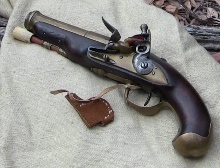Keith, I don't recall where I have read that, and if I could, it still might not meet your standards for "documentation". And I am well aware, through this Forum, that the argument of "common sense" - "in a tight situation, running out of cloth patches, the shooter might resort to ones of leather, rather than firing with a bare, undersized ball." - well, that just doesn't meet the standards of historic accuracy many of us strive for.
So, I can only respond by quoting information which you, yourself, posted on 14 May, 2011, in "A Woodsrunner's Diary" : "The first rifles were loaded by driving the lead ball down the barrel with a mallet, no patch was used. In Germany, they started using leather and cloth to patch the ball."
Now, I grant you that you were writing of rifles, and their use in Germany. We all know that many of those German gunsmiths came here to ply their trade, bringing their gunsmithing skills, and their shooting knowledge (including the use of leather patches). I think we can all agree that the use of patched roundballs was not common in smoothbores, and less so, leather patches.
But these were resourceful people, who used whatever was at hand, particularly if the question was one of survival. I do not see how we can categorically rule out the use of patches, leather or cloth, in a smoothbore.
As for the semantics of "patch" or "wad" - the paper surrounding the ball performed, among others, the same function that a patch would, i.e. lessening the freespace for the ball to wobble down the bore ( or fall out). It matters little whether an 18th century musketman would have referred to it as "wad", "wadding" or "patch". ( Similar to the historic vs contemporary terms "steel"/frizzen, "cock"/hammer, "tricker"/trigger.)
We may never find the desired documentation for this, and countless other questions re our historic interests. Can we say that leather patches, or any patches, were period correct. Probably not, with any kind of certainty. I have learned on this Forum, that some of our smoothbore shooters use paper cartridges, some use various waddings (grass, tow etc.), and some use patches on the roundball - because they have found that it works, making for a safe, accurate load. These latter folks may have come to smoothbores from shooting rifles, and didn't know that patching wasn't "HC" (I never knew about wadding until I came here.)
Is it not possible that some shooters in the 18th century had the same experience?
As always, we have no "argument". I have read your "A Woodsrunner's Diary" many times, always impressed with your dedication and knowledge. I was delighted to discover that you are a member of the Forum (for longer than I have been). My only disagreement is with your emphatic use of the term "NOT".
One of these days, I hope to join the rank of smoothbore shooters. When I do so, it will be with the knowledge I have gained from folks like you, Spence, Tenngun, and so many others here on the Forum.
Richard/Grumpa










